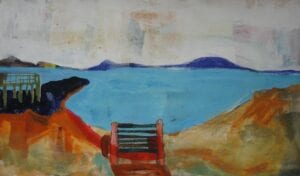Making Art is Human Nature
By Mason Gehring
April 30th, 2021

This is a selection of a paper I wrote my first semester at UF Art in Medicine graduate program. It’s a good overview of how arts can be used in a hospital setting and the ways the arts improves well-being of patients.
The use of visual arts in healthcare settings has a variety of ways to be implemented; from the observable to the interactive, visual art can play an important role in increasing a positive patient experience, reduce the length of stay, and boost morale of the staff. First, from the observable, the interior design of a waiting room, patient room, or operating room can be created to encourage calmness and give patients and family members positive visual stimuli to focus on, like the use of nature images has been shown to reduce the amount of pain medication needed post-surgery (Malenbaum, Keefe, Williams, Ulrich, & Somers, 2008). Specifically nature images are used because “patients exposed to the nature images reported significantly less anxiety than the other groups; patients who looked at abstract art had the highest level of anxiety.” (Malenbaum et al., 2008) Viewing a nature film in a setting where a patient feels removed from their life can return them to a less anxious state. A study “ found that those who viewed positive films, on average, achieved a pattern of cardiovascular activation akin to their resting levels within the first 20 seconds of watching the positive film.” (Fredrickson & Levenson, 1998)
Incorporating sunlight in postoperative spaces can reduce the amount of pain and the amount of medication needed was experienced by all ages. (Walch et al., 2005) Even the use of colored lighting can reduce stress on patients and it is no wonder that green and blue lighting have the highest results of stress reduction because of their similarity to natural settings. (Lankston, Cusack, Fremantle, & Isles, 2010)
Aside from developing artistic environmental settings that induce or focus stress reduction, the process of creating to alleviate stress can have a lifetime of positive impacts. In cases of patients with dementia there are studies that “much of the non-pharmacological research explores the use of the arts with persons who have dementia” because pharmacological treatments have not reversed or prevented Alzheimer’s disease. It seems that encouraging creativity and interaction creates a better quality of life (Beard, 2012)
Art a la Carte was created in 1994 by Debbie Baylin as a way to bring patient curated images into hospital rooms for long term patients. This organization also created Create While You Wait, which “provides individualized, small group creative art activities for patients recovering from strokes or brain injuries as well as adolescents receiving care for mental health illnesses. The act of co-creating art is not only a fun way to ease anxiety and boredom but it also provides an empathetic connection between patient and caregivers.” (“Art a la Carte,” n.d.) In the process of creation, a connection between patient and caregiver, patient and family, families and caregivers can accelerate progress because of this shared experience.
Using visual art in a healthcare setting is agreeing to treat the whole person. Here we watch a person be comforted by creating or by seeing beauty in a time when feeling isolated or removed from their life is normal. The use of art in healthcare in modern society is an attempt to reconnect the patient in a way that honors their spirits. We are not yet at the point of being as holistically as involved using art in healing as primitive cultures. We do not consistently use art in healing situations where the entire community is involved and the healing and art is experienced all at once. We are not experiencing art with the intention of healing in a healthcare setting. We are not prescribed a dance, we are not prescribed a painting or to sing.
Our use of art in healthcare is still in an individualized setting where patients will work one on one with an artist in residence or a small group of people may engage in an artistic exercise to express their feelings. The community involvement in the process of healing people or the community itself, as a form of healthcare, has not yet returned to modern society but a path has been made by the Arts in Healthcare field. For this to change, western society has to face how it values art, artists, and holistically treating a persons’ health. “Art, though, has stayed an essential nutrient of human culture, of our very humanity, since prehistoric application to visioning, dreaming, and worshiping.” (Serlin 2007).
References:
Art a la Carte. (n.d.). Retrieved January 29, 2018, from https://www.artalacarte.org/oma
Beard, R. L. (2012). Art therapies and dementia care: A systematic review. Dementia, 11(5), 633–656. https://doi.org/10.1177/1471301211421090
Fredrickson, B. L., & Levenson, R. W. (1998). Positive Emotions Speed Recovery from the Cardiovascular Sequelae of Negative Emotions. Cognition & Emotion, 12(2), 191–220. https://doi.org/10.1080/026999398379718
Lankston, L., Cusack, P., Fremantle, C., & Isles, C. (2010). Visual art in hospitals: case studies and review of the evidence. Journal of the Royal Society of Medicine, 103(12), 490–499. https://doi.org/10.1258/jrsm.2010.100256
Malenbaum, S., Keefe, F. J., Williams, A., Ulrich, R., & Somers, T. J. (2008). Pain in its Environmental Context: Implications for Designing Environments to Enhance Pain Control. Pain, 134(3), 241–244. https://doi.org/10.1016/j.pain.2007.12.002
Serlin, Ilene A., (2007) Whole Person Healthcare, Volume 3 The Arts and Health. San Fransisco, CA: Union Street Health Associates Press.
Walch, J. M., Rabin, B. S., Day, R., Williams, J. N., Choi, K., & Kang, J. D. (2005). The effect of sunlight on postoperative analgesic medication use: a prospective study of patients undergoing spinal surgery. Psychosomatic Medicine, 67(1), 156–163. https://doi.org/10.1097/01.psy.0000149258.42508.70


